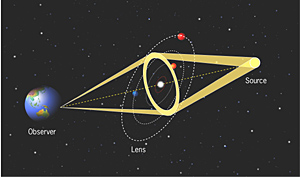GRAVITATIONAL MICROLENSING
Of course, there is no hope of observing this phenomenon directly – Albert Einstein (1936)
The phenomenon now known as gravitational microlensing was first described by Einstein in 1936 in a paper
on the lens-like action of a star by the deviation of light in the gravitational field (Science, Vol. 84, p. 506).
The phenomenon enables a distant star to be effectively magnified by the gravitational field of a nearer collinear
star as illustrated below.

Formation of an Einstein ring when two stars are collinear as seen from Earth. In this case a solar-like star is being lensed by a red dwarf. The radius of the Einstein ring is typically about 2 AU. The angular width of the ring is equal to the angular radius of the source star (S. Liebes, Physical Review, Vol. B133, p. 835).
The magnification is given by the ratio of the area of the Einstein ring to the area of the source star. It may reach values as high as 1,000. As noted by Einstein, the alignments that are needed to observe the effect are rare. Moreover, as all stars are in motion, they are brief and non-repeating. In typical examples, magnification is detectable over a period of about one month. Most examples of gravitational microlensing are observed in the dense stellar fields in the galactic bulge, as illustrated below.
 |
Gravitational lensing of a star at the far side of the galactic bulge by a star at the
near side as seen from the Earth.
